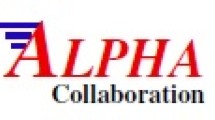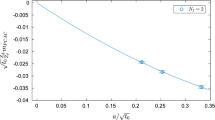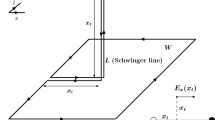Abstract
We discuss a confining model for charmonium in which the attractive force are derived from a new type of gauge field equation with a generalized SU3 gauge symmetry. The new gauge transformations involve non-integrable phase factors with vector gauge functions ω aω (x). These transformations reduce to the usual SU3 gauge transformations in the special case ω aμ (x) = ∂ μ ξ a(x). Such a generalized gauge symmetry leads to the fourth-order equations for new gauge fields and to the linear confining potentials. The fourth-order field equation implies that the corresponding massless gauge boson has non-definite energy. However, the new gauge boson is permanently confined in a quark system by the linear potential. We use the empirical potentials of the Cornell group for charmonium to obtain the coupling strength f 2/(4π) ≈ 0.19 for the strong interaction. Such a confining model of quark dynamics could be compatible with perturbation. The model can be applied to other quark-antiquark systems.
Similar content being viewed by others
References
E. Eichten, K. Gottfried, T. Kinoshita, J. Kogut, K.D. Lane, T.-M. Yan, Phys. Rev. Lett. 34, 369 (1975).
J.P. Hsu, Modern Phys. Lett. A 29, 1450031 (2014).
C.N. Yang, Phys. Rev. Lett. 33, 445 (1974).
J.P. Hsu, Phys. Rev. Lett. 36, 1515 (1976).
A. Pais, G.E. Uhlenbeck, Phys. Rev. 79, 145 (1950).
Y. Takano, Progr. Theor. Phys. 26, 304 (1961).
K. Andrzejewski, J. Gonera, P. Maślanka, Progr. Theor. Phys. 125, 247 (2011).
K. Huang, Quarks, Leptons and Gauge Fields (World Scientific, 1982) pp. 22--33, pp. 61--72 and pp. 241--245.
B.W. Lee, Jean Zinn-Justin, Phys. Rev. 7, 1047 (1973).
J.P. Hsu, Eur. Phys. J. Plus 127, 35 (2012) DOI:10.1140/epjp/i2012-12035-9.
I.M. Gel'fand, G.E. Shilov, Generalized Functions, Vol. 1 (Academic Press, New York, 1964) p. 363.
Particle Data Group, Particle Physics Booklet (IOP Publishing, 2010) p. 21.
J.P. Hsu, Mod. Phys. Lett. A 20, 2855 (2005).
J.P. Hsu, L. Hsu, Space-Time Symmetry and Quantum Yang-Mills Gravity (World Scientific, 2013) pp. 212--215 and p. 225.
T.D. Lee, Particle Physics and Introduction to Field Theory (Harwood Academic Publishers, Chur, London, 1981)pp. 584--587.
T. Kawanai, S. Sasaki, Phys. Rev. D 85, 091503(R) (2012).
G.S. Bali, Phys. Rep. 343, 1 (2001).
T. Barnes, S. Godfrey, E.S. Swanson, Phys. Rev. D 72, 054026 (2005).
H.B. Ai, J.P. Hsu, Found. Phys. 15, 155 (1985).
J.P. Hsu, Phys. Rev. D 26, 802 (1981).
J.P. Hsu, Nuovo Cimento B 88, 140 (1985).
Author information
Authors and Affiliations
Corresponding author
Rights and permissions
About this article
Cite this article
Hsu, JP. A confining model for charmonium and new gauge-invariant field equations. Eur. Phys. J. Plus 129, 108 (2014). https://doi.org/10.1140/epjp/i2014-14108-1
Received:
Revised:
Accepted:
Published:
DOI: https://doi.org/10.1140/epjp/i2014-14108-1




